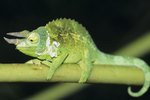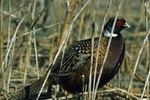
The lizard family Agamidae contains about five dozen species, which are native to Africa and Eurasia. Of those 60 or so species, Agama agama is the most populous. Aptly referred to as the common agama, these lizards are native to western Africa. A hardy species, the agama lizard has adapted to life in both rural and urban habitats.
General Habitat
Native to sub-Saharan Africa, Agama agama is well-suited to arid conditions. These lizards remain active throughout the day except for the hottest hour, when even shady spots can reach 100 degrees F. When the mercury climbs that high, even the agama finds a cool place to rest. The rainbow lizard lives in rural areas, but is also about as common in cities like Abidjan and Lagos as pigeons and squirrels are to New York City. They can be helpful to have around because they eat pest insects such as ants. They often congregate in the eaves of houses to rest for the night. When they rest, the dominant males turn to a dull brown color the same as the non-dominant males. In the morning as they bask their vibrant colors return. The dominant agama, called the cock, gets the best basking spot, followed by the subordinate males, and then the females.
Habitat and Food
Agamas can be found anywhere in western Africa that the environment provides enough food to support a population. Agamas are primarily insectivores. They're active hunters that chase their prey, snapping it up in their jaws or grabbing it with their sticky tongues. They've been known to eat ants, spiders, beetles, caterpillars and worms. Agamas can even leap into the air to snag a meal. Plants, berries, seeds and eggs from other smaller reptile species round out their diet.
Habitat Requirements for Reproduction
The annual rains in this part of Africa dictate when female agamas are able to reproduce. The abundant rains in March to May lead to high insect populations. This then allows the females to feed heavily and prepare themselves for egg laying between June and September. After copulating with the lead male in her group, the female agama digs a nest in moist, sandy soil in which plants are growing. She then deposits the eggs within the nest, which is about 2 inches deep. In a few months the hatchlings emerge.
Territory
Male agamas are territorial and must fight other males to claim their space. Agamas live in social groups including a lead male, about half a dozen females, and subordinate males. Subordinate males can only gain their own group if they eliminate the existing lead male -- the cock -- or establish a colony outside all other cocks' territory. Only the cock is allowed to mate with the females. The center of a cock's territory is usually marked by the presence of a physical object, such as a tree or boulder, on which the lizards congregate. In urban areas fights between males are more common because space is at a higher premium.
References
Resources
Photo Credits
-
Jupiterimages/Photos.com/Getty Images
Writer Bio
Madeline Masters works as a dog walker and professional writer. In the past she has worked as a fitness columnist, fundraising copywriter and news reporter. Masters won two Pennsylvania Newspaper Association Awards in 2009. She graduated from Elizabethtown College with a Bachelor of Arts in English.




